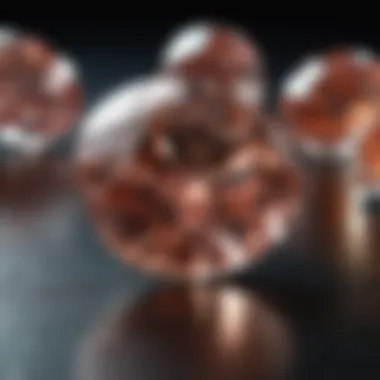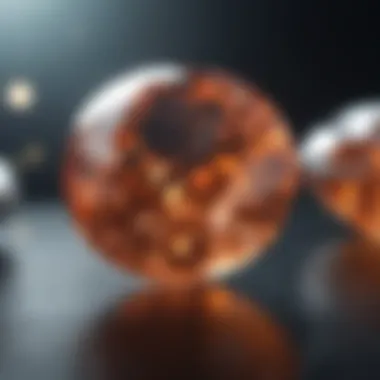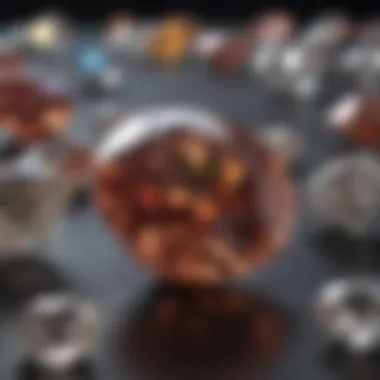Unveiling the True Value of Lab-Made Diamonds: An In-Depth Analysis


Overview of Lab-Made Diamonds
Lab-made diamonds, also known as synthetic diamonds or cultured diamonds, are man-made alternatives to natural diamonds. These diamonds are created in laboratories using cutting-edge technology that replicates the natural diamond-growing process under controlled conditions. The history of lab-made diamonds dates back several decades when scientists first successfully synthesized diamonds. Today, these gems have gained significant recognition for their quality, sustainability, and ethical aspects. In cultures where natural diamonds hold traditional value, lab-made diamonds are sparking conversations about a more sustainable and eco-friendly approach to luxury.
Deciphering the True Value
Understanding the pricing of lab-made diamonds entails a comprehensive analysis of various factors that influence their cost. Unlike natural diamonds that are subject to mining, environmental impacts, and limited supply, lab-made diamonds offer a more predictable pricing model due to their controlled production process. Factors such as carat weight, cut quality, color grade, and clarity characteristics play a crucial role in determining the value of lab-made diamonds. By delving into these pricing components, consumers can make informed decisions about their diamond purchases, considering both financial aspects and ethical considerations.
Market Dynamics and Consumer Preference
The market for lab-made diamonds has been experiencing significant growth in recent years, fueled by shifting consumer preferences towards sustainable and ethically sourced products. As more consumers prioritize environmental and social responsibility, lab-made diamonds have emerged as a compelling choice for engagement rings, fine jewelry, and investment pieces. This changing consumer landscape is reshaping the diamond industry, with established brands and emerging designers increasingly incorporating lab-made diamonds into their collections. By examining market trends, consumer behaviors, and industry outlook, stakeholders can gain valuable insights into the evolving dynamics of the lab-made diamond market.
Sustainability in Sparkle
One of the key advantages of lab-made diamonds lies in their sustainable production process. Unlike natural diamonds that require extensive mining operations, potentially harmful to the environment and communities, lab-made diamonds are created in controlled laboratory settings with minimal environmental impact. By exploring the sustainability aspects of lab-made diamonds, from energy-efficient production methods to reduced carbon footprint, consumers can align their purchasing decisions with environmental consciousness. The eco-friendly appeal of lab-made diamonds is resonating with a growing segment of environmentally aware consumers seeking luxury options that reflect their values.
The Promise of Perfection
When it comes to quality and consistency, lab-made diamonds offer a level of precision that surpasses natural diamonds. The controlled growth environment in laboratories enables scientists to engineer diamonds with exceptional clarity, color, and cut precision, leading to stones that exhibit near-flawless characteristics. This promise of perfection in lab-made diamonds appeals to discerning buyers who seek impeccably crafted gems with impeccable quality standards. By exploring the craftsmanship behind lab-made diamonds and the pursuit of perfection in each facet, consumers can appreciate the artistry and dedication that elevate these synthetic gems to a superior level of brilliance.
Introduction to Lab-Made Diamonds
In an era marked by technological advancements and a growing emphasis on sustainability, lab-made diamonds have emerged as a fascinating alternative to natural diamonds. These synthetic gems, cultivated under controlled laboratory conditions, offer a range of advantages that set them apart from their mined counterparts. As consumer awareness regarding ethical sourcing and environmental impact increases, the appeal of lab-made diamonds continues to rise.
Understanding Lab-Made Diamonds
Diamond Replication Process
The diamond replication process involves recreating the natural formation of diamonds through high-pressure, high-temperature conditions in a laboratory setting. This meticulous procedure allows scientists to replicate the crystalline structure of diamonds with remarkable precision. By controlling the variables during synthesis, experts can produce diamonds that exhibit equally stunning optical properties as natural diamonds. This process offers a more sustainable and conflict-free alternative to mining, making it a preferred choice for environmentally conscious consumers.
Types of Lab-Made Diamonds
Lab-made diamonds come in various types, including High Pressure-High Temperature (HPHT) and Chemical Vapor Deposition (CVD) diamonds. HPHT diamonds are created by subjecting a diamond seed to extreme pressure and heat, mimicking the natural conditions that form diamonds deep within the Earth. On the other hand, CVD diamonds grow layer by layer from a carbon-rich gas, resulting in exceptional purity and clarity. Each type offers distinct advantages, catering to different preferences in terms of color, size, and quality.
Differentiating Lab-Made and Natural Diamonds


Chemical Composition Analysis
One of the key methods for distinguishing lab-made from natural diamonds is through chemical composition analysis. By examining the trace elements and impurities present in the diamond structure, experts can determine its origin. Lab-made diamonds often exhibit minor discrepancies in composition compared to natural diamonds, enabling gemologists to identify their synthetic nature. This analytical approach plays a crucial role in verifying the authenticity of diamonds, ensuring transparency in the gemstone industry.
Physical Properties Distinction
Beyond chemical composition, physical properties such as hardness, density, and thermal conductivity provide additional insights into differentiating lab-made and natural diamonds. While lab-made diamonds share many characteristics with their mined counterparts, subtle variations in properties can indicate their synthetic origin. Advanced testing methods offer a comprehensive evaluation of these properties, enabling gemologists to make informed distinctions between lab-made and natural diamonds.
Evolution of Lab-Made Diamonds
Technological Advancements
The continuous evolution of diamond synthesis techniques has revolutionized the production of lab-made diamonds. Innovative technologies now enable scientists to create larger, higher-quality diamonds with greater efficiency. Advanced equipment and methods have streamlined the manufacturing process, resulting in enhanced precision and customization options for consumers. These technological advancements position lab-made diamonds as a sophisticated and sustainable choice in the fine jewelry market.
Market Trends
With shifting consumer preferences towards ethical and sustainable products, lab-made diamonds have grown in popularity across the jewelry industry. Market trends indicate a rising demand for eco-friendly and socially responsible gemstones, driving the adoption of lab-made diamonds among retailers and consumers alike. As awareness of the environmental impact of traditional mining practices increases, the market for lab-made diamonds is projected to expand, reflecting a broader shift towards conscious consumption.
Factors Affecting Lab-Made Diamond Prices
In the intricate realm of lab-made diamonds, understanding the factors influencing prices is paramount. This section dives deep into the critical elements that determine the valuation of lab-grown diamonds. From production costs to market demand, each factor plays a significant role in shaping the pricing landscape.
Cost Components Analysis
Production Costs
Production costs are a fundamental aspect contributing to the overall pricing structure of lab-made diamonds. These costs encompass various processes involved in creating synthetic diamonds, such as raw material expenses, energy consumption, and labor costs. The efficiency of production techniques and the scale of operations can heavily influence these expenses. Despite being meticulous and detail-oriented processes, keeping production costs in check is essential for ensuring the economic viability of lab-grown diamond production. While high production costs may indicate advanced technology and superior quality, they also need to be balanced with market competitiveness.
Quality Control Expenses
Quality control expenses form another vital component in determining the final pricing of lab-made diamonds. Maintaining stringent quality standards throughout the manufacturing process is imperative to produce diamonds that meet industry specifications and consumer expectations. Quality control measures include precision testing, grading, and certification to verify the authenticity and quality of each lab-created gem. While these expenses add to the overall cost, they are essential for establishing trust and credibility within the market. Effective quality control practices can enhance the perceived value of lab-grown diamonds and differentiate them from natural alternatives.
Certification Charges
Certification charges play a crucial role in validating the authenticity and quality of lab-made diamonds. Independent certification bodies assess various aspects of synthetic diamonds, including their chemical composition, physical properties, and ethical sourcing. These certifications provide consumers with confidence in the product's specifications and ensure compliance with industry standards. While certification charges contribute to the overall pricing of lab-grown diamonds, they offer transparency and assurance to buyers, reinforcing the value proposition of these sustainable gems.


Market Demand Influence
Consumer Preferences
Consumer preferences serve as a significant driver of market demand for lab-made diamonds. Shifting trends towards sustainable and ethical jewelry choices have propelled the popularity of synthetic stones among conscientious consumers. Factors such as origin traceability, environmental impact, and social responsibility influence purchasing decisions in the modern jewelry market. Understanding and adapting to evolving consumer preferences are essential for manufacturers and retailers to capitalize on the growing demand for lab-created diamonds.
Industry Trends
Industry trends play a pivotal role in shaping the market landscape for lab-made diamonds. Innovations in manufacturing technologies, changes in consumer buying behavior, and industry regulations significantly impact the demand and supply dynamics of synthetic diamonds. Anticipating and responding to emerging trends, such as customization options, digital marketing strategies, and blockchain integration, can provide competitive advantages in a rapidly evolving market. Adapting to industry trends is essential for staying relevant and competitive in the dynamic world of lab-grown diamonds.
Supply Chain Dynamics
Raw Material Sourcing
Raw material sourcing is a critical aspect of the supply chain for lab-made diamonds. The quality and origin of materials, such as carbon sources and catalysts, directly impact the final characteristics of synthetic diamonds. Sustainable sourcing practices, responsible mining initiatives, and ethical procurement strategies are gaining prominence in the diamond industry. Ensuring transparency and traceability in raw material supply chains not only enhances product quality but also aligns with ethical and environmental values, meeting the increasing demands of conscious consumers.
Distribution Channels
Distribution channels play a vital role in connecting lab-created diamonds with end consumers. Efficient distribution networks enable seamless access to synthetic diamonds across various markets and segments. Direct-to-consumer models, online retail platforms, and collaborations with jewelry designers are reshaping traditional distribution channels in the gemstone industry. Balancing convenience, affordability, and product visibility is key to optimizing distribution strategies for lab-grown diamonds. By leveraging diverse channels, manufacturers can broaden their reach and appeal to a broader audience of gemstone enthusiasts, fostering sustainable growth and brand loyalty.
Comparative Value Analysis
In the domain of gemstones and luxury accessories, the Comparative Value Analysis holds paramount significance. It serves as a tool for discerning buyers, traders, and enthusiasts, enabling them to make informed decisions regarding their investments and collection strategies. Within the context of lab-made diamonds, conducting a Comparative Value Analysis involves scrutinizing various aspects such as pricing differentials, market trends, and ethical considerations. By juxtaposing lab-made diamonds against their natural counterparts, stakeholders can assess the true worth of these synthetic gems.
Economic Considerations
Pricing Variance with Natural Diamonds
One crucial aspect of lab-made diamonds that garners attention in the Economic Considerations segment is the Pricing Variance with Natural Diamonds. This element underscores the fluctuation in prices between lab-created and natural diamonds, shedding light on the cost differentials that drive consumer preferences. The Pricing Variance signifies the potential cost savings associated with opting for lab-made diamonds over mined ones. This aspect appeals to budget-conscious consumers seeking elegant and affordable jewelry options.
Long-Term Investment Potential
When contemplating the Long-Term Investment Potential of lab-made diamonds, one appreciates their stability and enduring value proposition. Unlike natural diamonds, which are subject to market fluctuations and ethical controversies, lab-made diamonds offer a predictable investment avenue. Their consistent quality, coupled with a burgeoning demand for sustainable and conflict-free gems, positions them as a lucrative long-term asset. Investors keen on diversifying their portfolios often find solace in the enduring allure of lab-made diamonds.
Environmental Implications


Sustainability Benefits
Embracing Sustainability Benefits in the production and consumption of lab-made diamonds embodies a conscientious choice towards environmental preservation. By opting for sustainable practices in gemstone manufacturing, stakeholders contribute to the reduction of ecological footprints associated with traditional diamond mining. The emphasis on responsible sourcing and ethical production methods distinguishes lab-made diamonds as environmentally-friendly alternatives, appealing to eco-conscious consumers seeking ethically-sourced luxury.
Carbon Footprint Assessment
In the realm of lab-made diamonds, the emphasis on Carbon Footprint Assessment underscores a commitment to environmental stewardship and resource efficiency. By quantifying the greenhouse gas emissions and energy consumption related to diamond production, manufacturers and buyers gain insights into the environmental impact of their choices. The conscientious measurement and mitigation of carbon footprints align with global sustainability goals, positioning lab-made diamonds as eco-friendly creations with a reduced environmental burden.
Ethical Dimensions
Conflict-Free Sourcing
At the core of Ethical Dimensions lies the principle of Conflict-Free Sourcing in the lab-made diamond industry. This aspect underscores a commitment to sourcing raw materials from regions free of humanitarian conflicts or unethical practices. By ensuring that diamonds are ethically sourced and processed, stakeholders uphold human rights standards and promote social responsibility across the supply chain. The emphasis on conflict-free practices reflects a moral imperative in the luxury goods sector, resonating with consumers who value transparency and integrity.
Social Responsibility Impact
Delving into the Social Responsibility Impact of lab-made diamonds illuminates the industry's role in driving positive change and community development. By prioritizing social responsibility initiatives, such as fair labor practices and community reinvestment programs, stakeholders contribute to the socio-economic progress of diamond-producing regions. The pervasive impact of social responsibility extends beyond ethical sourcing, fostering sustainable livelihoods and empowering marginalized communities. Embracing social responsibility as a core tenet underscores the transformative potential of lab-made diamonds in creating a more equitable and ethical gemstone supply chain.
Conclusion: Deciphering the True Worth
In wrapping up this detailed exploration of lab-made diamonds, the aspect of deciphering the true worth emerges as a pivotal theme within the context of this article. Shedding light on the nuanced evaluation of lab-made diamonds against their natural counterparts, this conclusion encapsulates the culmination of insights garnered throughout the previous sections. By synthesizing the intricate interplay between pricing factors, market trends, and sustainability considerations, readers are equipped with a profound understanding of the complexities defining the true value of lab-made diamonds. This section serves as a crucial reflective point, urging readers to contemplate the holistic implications of lab-grown diamonds within the ever-evolving landscape of the jewelry industry.
Key Insights on Lab-Made Diamond Pricing
Balancing Cost and Value
Delving into the realm of 'Balancing Cost and Value' within the sphere of lab-made diamond pricing, a fundamental cornerstone of this discussion emerges. This intricate balance between the financial investment and the inherent value proposition of lab-grown diamonds showcases a nuanced confluence of economic considerations. The unique allure of 'Balancing Cost and Value' lies in its ability to offer consumers a compelling fusion of affordability without compromising on quality, making it a viable choice for those seeking a prudent investment in the brilliance of lab-created diamonds. Despite its advantages, potential drawbacks may manifest in the form of fluctuating market prices or evolving consumer preferences, underscoring the need for astute navigation of this delicate equilibrium to maximize the benefits inherent in this pricing strategy.
Future Trends Forecast
Forecasting the future trends within the lab-made diamond sphere unveils a captivating narrative steeped in innovation and evolving market dynamics. The prognostication of 'Future Trends Forecast' plays a pivotal role in shaping strategic decisions and anticipatory measures within the jewelry industry. By highlighting emerging patterns, technological advancements, and shifting consumer sentiments, this aspect offers readers a glimpse into the potential trajectory of lab-grown diamonds. The inherent advantages of 'Future Trends Forecast' lie in its capacity to empower stakeholders with informed insights, enabling proactive adaptation to the ever-changing landscape of diamond production and market demands. However, prudent consideration of potential risks and uncertainties is paramount in harnessing the full potential of these projected trends.
Final Thoughts
Informed Decision-Making
Navigating the intricacies of 'Informed Decision-Making' underscores a critical component in the realm of lab-made diamonds, epitomizing the essence of knowledge-driven choices. This facet emphasizes the importance of comprehensive research, industry awareness, and ethical considerations in guiding consumers towards judicious investment decisions. The key characteristic of 'Informed Decision-Making' lies in its capacity to empower individuals with the requisite tools to discern between various diamond options, ensuring optimal outcomes aligned with personal preferences and ethical convictions. As a beneficial choice for this article, 'Informed Decision-Making' augments the reader's capacity to navigate the multifaceted landscape of lab-grown diamonds with clarity and purpose.
Continuous Evolution in Diamond Industry
Embarking on a discourse surrounding the 'Continuous Evolution in Diamond Industry' illuminates a transformative narrative characterized by innovation and adaptation. This aspect underscores the perpetual progression and adaptation witnessed in the dynamic arena of diamond production and consumer preferences. The intrinsic allure of 'Continuous Evolution in Diamond Industry' lies in its ability to foster a culture of ingenuity, sustainability, and advancement within an age-old industry. While offering a plethora of advantages in terms of technological advancements and ethical practices, this facet also necessitates a prudent approach to mitigate potential challenges arising from rapid industry shifts and evolving regulatory landscapes. Embracing this facet within the narrative of this article bolsters a deeper appreciation for the ever-evolving nature of the diamond industry and the transformative potential inherent within this continuous evolution.







